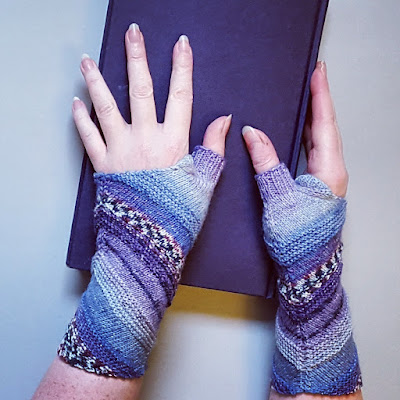Since they don't cover much of the hands, they are rather wrist warmers than fingerless gloves.
About 4 years after publishing this pattern, Bernadette from Törtchens Blog tried to translate this pattern into German (thank you!!). And during the course of this translation, she discovered quite a few mistakes. So, in October 2017 I duly corrected them.
The German translation is available here.
Eine deutsche Übersetzung findet sich hier. (erstellt von Bernadette von Törtchens Blog)
This work by Knitting and so on is licensed under a Creative Commons Attribution-NonCommercial-ShareAlike 4.0 International License.
Materials
- about 40 grams of fingering weight yarn
- 2.5 mm needles
- 3 (different) stitch markers
Techniques:
- Knitted cast-on: http://www.youtube.com/watch?v=-nJKC2xT0Q4

Construction
These mitts are constructed in a different manner of the normal in-the-round loom-style fingerless gloves. They are started at the lower edge with only 4 stitches CO. Then a triangle is knitted flat (part I); when the lower edge is wide enough, both ends are joined in the round and knitted upwards diagonally (part 2). Part 3 is knitted flat with decreases at the upper end, while part 4 is knitted in the round again, drecreasing again until thumb width is reached (see picture on the right).
Instructions
Part I - knitted flat
CO4
Set-up row: k2 place marker k2 (this marker will be called middle marker)
Row 1: kfb; k to st before marker kfb; slip marker; kfb k to last stitch; kfb
Row 2: k
Repeat until there are 60 sts on your needles (or until the lower edge is wide enough to fit around your wrists).
End with row 1,
then join in round - place marker (this marker will be called end marker)
Part II - in the round
Round 1: k
Round 2: k2tog; k until 1 st before middle marker; kfb; slip marker; kfb; k until 2 sts before end marker; ssk
Repeat these 2 rounds a total of 5 times
Round 11: p
Round 12: k2tog; k until 1 st before middle marker; kfb; slip marker; kfb; k until 2 sts before end marker; ssk
Repeat rounds 11 and 12 a total of 5 times
Round 21: k
Round 22: k2tog; k until 1 st before middle marker; kfb; slip marker; kfb; k until 2 sts before end marker; ssk
Repeat rounds 21 and 22 a total of 5 times
Round 31: p
Round 32: k2tog; k until 1 st before middle marker; kfb; slip marker; kfb; k until 2 sts before end marker; ssk
Repeat rounds 31 and 32 a total of 5 times
Round 41: k
Round 42: k2tog; k until 1 st before middle marker; kfb; slip marker; kfb; k until 2 sts before end marker; ssk
Repeat rounds 41 and 42 a total of 5 times
Afterwards k to middle marker - remove middle marker; and TURN WORK.
Now there is only one marker left.
 Part III - knitted flat
Part III - knitted flatRow 1: k to last stitch before end – if you want to avoid a gap at the upper outer edge, you can now connect the first and last stitches of that row like this: slip the last stitch to the right needle and - using a crochet hook - draw the working yarn through the first stitch of that row, put the loop on the left needle, move the last (not yet knitted) stitch back to the left needle, knit the two stitches together (see picture on the left). Alternatively, just knit the last stitch.
Row 2: ssk; k until the last two stitches; k2tog
Row 3: k
Row 4: ssk; k until two stitches before marker; ssk; slip marker; k2tog; k until two stitches before end; k2tog
Row 5: k
Repeat rows 2-5 rows twice more more.
Row 11: p
Row 12: ssk; k until two stitches before marker; ssk; slip marker; k2tog; k until two stitches before end; k2tog
Row 13: p
Row 14: ssk; k until the last two stitches; k2tog
(if you started part 2 at 60 stitches, you should now have 40 sts on your needles)
 Place marker (this will be called M2) and add 20 stitches by using a knitted cast on – place marker (this is the new „round end marker“) join in round. The picture on the right shows the naming and placement of the markers. I opted to distribute the stitches on three needles instead of using markers.
Place marker (this will be called M2) and add 20 stitches by using a knitted cast on – place marker (this is the new „round end marker“) join in round. The picture on the right shows the naming and placement of the markers. I opted to distribute the stitches on three needles instead of using markers.Part IV & thumb - knitted in the round
Round 1: k to M2: ssk *k1 p1 (repeat from * to two sts before) marker k2tog slip marker (this creates a small ribbing at the upper edge to prevent it from rolling)
Round 2: k to M2: ssk *p1 k1 (repeat from * to two sts before) marker k2tog slip marker (this creates a small ribbing at the upper edge to prevent it from rolling)
Round 3 = Round 1
Round 4: ssk k to two stitches before marker k2tog, repeat once more; you're now at M2, ssk *p1 k1 (repeat from * to two sts before) marker k2tog slip marker
Round 5: ssk k to two stitches before marker k2tog; repeat three times
Round 6: k all
Round 7 = Round 5
Round 8 = Round 5
Round 9 = Round 6
Repeat rounds 7 to 9 once more
– if you started part 2 at 60 stitches, you should now have 18 sts on your needles.
For the thumb, knit 9 rounds of k2 p1-ribbing, bind off in pattern in 10th round.
Weave in ends.
Make two.






Keine Kommentare:
Kommentar veröffentlichen